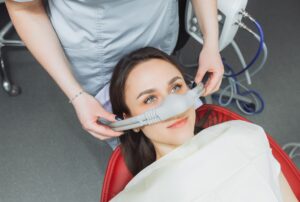
Did you know that an estimated 36% of Americans experience anxiety when it comes to dental appointments? In fact, some people are so scared that their fear keeps them from getting the essential care they need to maintain a happy, healthy smile.
You might hesitate to schedule a checkup or undergo a more complex procedure when you’re overwhelmed with worry. Your dentist can provide sedatives to help you feel more relaxed throughout your visit, but unfortunately, many patients refuse these services because they have a false understanding of what’s involved. Continue reading to learn about three common myths about dental sedation and the truths behind them so you can set your concerns aside!
Myth #1: It’s Reserved for Complex Cases
It’s not uncommon for patients to grow more nervous when their provider suggests sedation because they assume the medications are only used in the most extreme circumstances. While your doctor might only offer them for more invasive surgeries, the same isn’t necessarily true for your dentist. They might suggest these services to help anyone who:
- Experiences moderate to severe dental anxiety.
- Has difficulties sitting still for longer periods.
- Is allergic or resistant to topical anesthetics.
- Will be undergoing a more complex or lengthy procedure.
- Is receiving multiple treatments in a single appointment.
Myth #2: There’s Only One Type
Several medications can be used for dental sedation, and each requires different levels of training and licensing to administer. Your dentist might offer a single method or several, depending on their qualifications. They’ll let you know which they think best suits your unique circumstances. The three common types include:
- Nitrous oxide (laughing gas). This may be the most widely used option because it’s considered the safest for the greatest number of people. It’s delivered through a mask that’s placed over your nose for the duration of your appointment, and the effects wear off within minutes of its removal.
- Oral conscious sedation. Your dentist can write a prescription for this pill, which you’ll be instructed to take before your visit so the drug kicks in by the time we begin working on your teeth.
- IV (intravenous) sedation. This is considered the most potent medication and is administered directly to your bloodstream. You likely won’t remember the details of your procedure and will need someone to drive you home afterward.
Myth #3: It “Knocks You Out”
You might avoid sedatives if you’re worried that they’ll render you comatose right away, but that’s usually not the case. For example, laughing gas induces a happy, euphoric sensation that’s more likely to leave you giggling than unconscious. With oral conscious sedation, you might feel relaxed enough to drift off, but usually, you’re awake enough to follow your dentist’s instructions or answer their questions. The goal isn’t to put you to sleep necessarily but to help you feel calm and comfortable enough to make it through your visit successfully.
If your dental anxiety has kept you from getting the care you need, ask your dentist whether they provide sedatives that can help!
About the Author
Dr. Ashraf Seif has 20+ years of experience helping people enhance their lives by improving their oral health. He obtained his first dental degree in Syria where he grew up, and then graduated from the Loma Linda School of Dentistry after relocating to the U.S. He has since completed additional hours of ongoing education in oral sedation, so you can trust that you’re in good hands. He combines a caring, compassionate approach with state-of-the-art equipment to enhance your comfort and provide accurate, long-lasting results. To learn more about dental sedation options, you can contact the office on the website or call (281) 837-9122.
